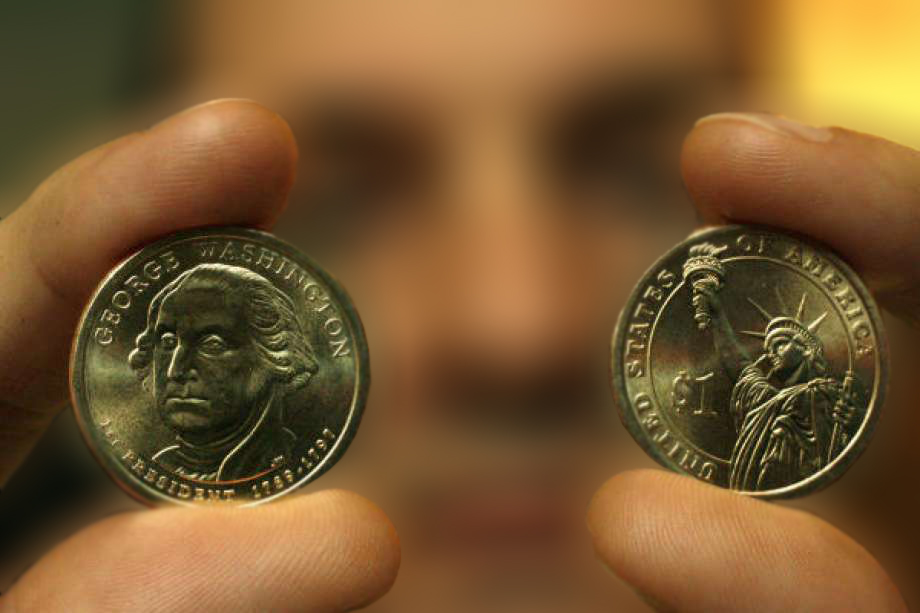I’m legally blind. I can see some things, but it’s easier to use adaptive techniques of blindness to do a lot of stuff when my lack of visual acuity makes things frustrating.
What I’m going to talk about is how a legally blind person( no vision at all) can tell one coin from another. The same techniques used by the totally blind can also be used by those with less-than-perfect vision to maintain their independence.
In this discussion, I’m going to demonstrate the technique on the four most commonly used coins, the penny, the nickel, the dime, and the quarter.
I don’t remember the last time I saw a half dollar, and it was several decades ago since I saw a two dollar bill, or a Susan B. Anthony coin. So, I wont be discussing those. I’m just going to stick with the four basic ones that are probably jingling in your pocket as you read this.
There are clues, tactile clues, that are really easy to learn if you’re vision impaired, that make it so easy to tell which coin is which. So, when the cashier gives you your money back, breaks a dollar, whatever, you can tell right away if you’ve gotten the right change.
Let’s start with the smallest denomination of coin, the penny. Let me tell you there are two tactile characteristics that are used by the blind to tell which coin is which. One is the obvious one, the size and weight of the coin. That tells you a lot, but there’s another characteristic, the edge. On some of the coins, the edge is flat, just like on the penny. On other coins, the edge has ridges you can feel with your fingertips.
If you run your nail across the edge of a coin that has ridges, you’ll actually hear it. Those two combinations of tactile feedback: the size of the coin plus ridges tells you for sure which coin is which.
Starting our demonstration with the penny. The one I am holding is both very small and very tarnished.
You can tell it is a penny because it’s one of the smallest coins we have. Plus, it has a smooth edge.
In the dark, if someone hands me change, I don’t have to pull it out, hold it up to the light, or stick it to my eye to know what it is. I can tell right away just by using the tactile characteristics of the coins.
I don’t even have to remove the coin from my pocket in order to tell this is a penny.
The way to tell a penny, is that it is the second smallest coins, and has no ridge along the outside.
The Next larger denomination we will be examining is the nickel. I’ll be perfectly honest, when I hold a nickel and a quarter in the same hand, I can tell right away which is which. But, if I only feel them individually, I have the worst time telling which is which just by comparing the size.
It is very easy to identify a nickel. You can tell the nickel by it’s size and its lack of a outside ridge. if you find a coin that’s bigger than the penny or the dime, and it has smooth edges, you know that’s a nickel.
The next denomination I will be describing is the dime. The dime is smaller than a penny and a bit thinner. What makes a dime easily identifiable is its smaller size and its ridges. You cannot mistake a dime for any other coin.
The last denomination is the quarter– The twenty-five cent piece. The reason they call it a quarter is because in the olden days, the way they made change from a dollar coin was they cut it into quarters; fourths. You got really weird shaped edges, but that’s where we got the term quarter.
Today, quarters are their own coin. One of the largest that we have and One of the largest that you’re likely to receive in your day-to-day commerce. Quarters are not only distinctive because of their size. They also has ridges like the dime.
Let’s review. The four major coins I examined were the penny, dime, nickel, and quarter. And, it is so easy to tell which one is which — just by using a few adaptive techniques.
The penny is one of the smallest coins and a bit bigger than a dime. And, the penny has no ridges.
the nickel is bigger than a dime or penny and has no ridges.
The dime is the Smallest, most diminutive of coins that we have with ridges. In your pocket you find something small, it might be a penny, might not be a penny, check the ridges. If there are ridges it’s a dime, no ridges, it’s probably a penny.
The quarter is probably the largest coin you’ll have in your pocket and is easily identifiable because it has ridges.
When one way of doing things outlives its usefulness, it is time to open your mind to new ones. You have nothing to lose but your frustration.


0 Comments